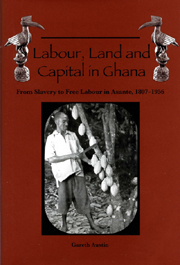Book contents
- Frontmatter
- Contents
- List of Illustrations
- List of Tables
- Preface
- Note on Names
- Maps
- Note on the Maps
- 1 Introduction
- Part I Context and Concepts
- Part II Social Relations of Production and Trade, 1807–1896: Absent and Imperfect Factor Markets
- Part III Slavery as Hobson's Choice: An Analysis of the Interaction of Markets and Coercion in Asante's Era of ‘Legitimate Commerce’, 1807–1896
- Part IV The Decline of Coercion in the Factor Markets of Colonial Asante: Cocoa and the Ending of Slavery, Pawnship and Corvée, 1896–c.1950
- 11 Why Was Prohibition So Long Delayed? The Nature and Motives of the Gradualism of the British ‘Men on the Spot’
- 12 The Decline of Coerced Labour and Property in Persons in Practice: Change from Above and from Below in Colonial Asante, 1896–1950
- 13 Cocoa and the Ending of Labour Coercion, c.1900–c.1950
- Part V Social Relations of Production and Trade, 1908–1956: Towards Integrated Factor Markets?
- Part VI Freedom and Forest Rent, 1908–1956
- Abbreviations Used in the Notes
- Notes
- List of References
- Index
12 - The Decline of Coerced Labour and Property in Persons in Practice: Change from Above and from Below in Colonial Asante, 1896–1950
from Part IV - The Decline of Coercion in the Factor Markets of Colonial Asante: Cocoa and the Ending of Slavery, Pawnship and Corvée, 1896–c.1950
Published online by Cambridge University Press: 12 September 2012
- Frontmatter
- Contents
- List of Illustrations
- List of Tables
- Preface
- Note on Names
- Maps
- Note on the Maps
- 1 Introduction
- Part I Context and Concepts
- Part II Social Relations of Production and Trade, 1807–1896: Absent and Imperfect Factor Markets
- Part III Slavery as Hobson's Choice: An Analysis of the Interaction of Markets and Coercion in Asante's Era of ‘Legitimate Commerce’, 1807–1896
- Part IV The Decline of Coercion in the Factor Markets of Colonial Asante: Cocoa and the Ending of Slavery, Pawnship and Corvée, 1896–c.1950
- 11 Why Was Prohibition So Long Delayed? The Nature and Motives of the Gradualism of the British ‘Men on the Spot’
- 12 The Decline of Coerced Labour and Property in Persons in Practice: Change from Above and from Below in Colonial Asante, 1896–1950
- 13 Cocoa and the Ending of Labour Coercion, c.1900–c.1950
- Part V Social Relations of Production and Trade, 1908–1956: Towards Integrated Factor Markets?
- Part VI Freedom and Forest Rent, 1908–1956
- Abbreviations Used in the Notes
- Notes
- List of References
- Index
Summary
Even when slavery and human pawning were banned, they were far from extinguished. This chapter considers how far and how fast slavery and pawning declined in practice, following the early suppression of the slave trade (and thus of imports of new captives) and of panyarring, the practice of seizing hostages to enforce repayment of outstanding debts. The evidence indicates that emancipation owed much to the initiative of slaves themselves, and their kin. It also shows that slavery and pawning lasted long enough to be important sources of labour in early Asante cocoa-farming. The same applies to the Asante form of corvée, in which subjects were expected to give labour service to the chief. We will see that emancipation was very uneven in social terms: the timing varied according to the age and, especially, the gender of the slave or pawn. The destiny of slaves or former slaves was also crucially shaped by whether they had originally been taken from outside the Akan world.
Before considering what happened with each of these institutions, it is appropriate to comment on the notorious source problems involved in trying to track the destinies of actual and former slaves and pawns in Africa. For Asante at least, the difficulties are less than has sometimes been supposed. To be sure, the customary secrecy about people's origins is far from dead, and it seems inconceivable that any sample survey could obtain respondents' full and frank answers to the kind of questions necessary to establish whether, for instance, the average income of people descended from slaves has caught up with that of the rest of the Asante population.
- Type
- Chapter
- Information
- Labour, Land and Capital in GhanaFrom Slavery to Free Labour in Asante, 1807–1956, pp. 215 - 235Publisher: Boydell & BrewerPrint publication year: 2005

